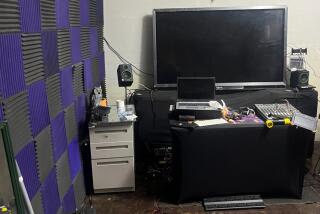Mojave Desert Makes an Ideal Parking Lot : Military: The huge storage area at the Marine Corps base near Barstow has been a key supply and repair facility for 48 years.
- Share via
BARSTOW — It is the biggest parking lot, storage area and garage on the Mojave Desert.
Its purpose is a mystery to most of the thousands of motorists driving Interstate 15 who pass it each week.
Parked in the open desert along the busy highway eight miles east of downtown Barstow are rows of M-60 tanks, trucks and a variety of military equipment.
This is the U.S. Marine Corps Logistics Base, Barstow, for 48 years a key supply and repair base for the Marines, especially important now during Operation Desert Shield.
There are only two Marine Corps logistics bases--here and at Albany, Ga.
“Since Aug. 10, when America reacted to Iraq’s invasion of Kuwait, thousands of tons of supplies have been shipped from here to Marines now stationed in Saudi Arabia,” said Brig. Gen. John Brickley, 52, base commander.
Track vehicles, rolling stock, forklifts, earth-moving equipment, gas masks, clothing and rations have been shipped from the base to Marines halfway around the world in the Mideast.
The Marines have 13 freighters stationed in strategic locations in the world, floating warehouses carrying battle-ready equipment and supplies that are set to sail on a moment’s notice wherever a crisis occurs.
Several floating warehouses were in the Mideast when Iraq invaded. The ships sailed to Saudi Arabia, where they were met and unloaded by Marines.
Now, when Marines in Desert Shield need parts, replacements, supplies--everything to support ground forces except ammunition--the two logistics bases will fill the orders.
Ever since World War II, the logistics base here has been an economic mainstay for Barstow, population 20,000. The base is one of the area’s largest employers with an annual payroll of $73.4 million.
Employed at the Marine base are 1,980 civilians, 650 Marines and a dozen Navy personnel. Members of the military are generally stationed here two or three years. The majority of civilians have worked here more than 20 years, some for 40 years.
The Marines’ largest building anywhere is the 1,050-foot-long repair facility--longer than three football fields. It is 10 acres under one roof, where 800 civilians and 155 Marines repair and maintain equipment.
Here, the $872,000 M-60 tanks are periodically serviced, as are the $600,000 assault amphibious vehicles (AAVs); HMMWVs--the high mobility multipurpose wheeled vehicles that replaced the jeep, and all other rolling stock of the Marine Corps.
The largest Department of Defense railhead is located on the base. It serves both the Marine base and the Army’s nearby Ft. Irwin. One building is a huge facility where vehicles are X-rayed to find cracks in armor plates.
Two miles of old California 66 run through the heart of the 5,687-acre base where some of the streets, such as Iwo Jima and Tarawa, carry the names of famous World War II Marine battles.
There are 3.4-million square feet under roof and 14-million square feet of open storage area at the base.
“It’s the extreme dry weather out here on the desert, the absence of rainfall, the low humidity, limited mold, rust and mildew to equipment stored outside that brought the Marines here in the first place,” said Col. William Sahno, 51, director of the Base Materiel Division.
“Outdoor cost of storage, obviously, is minimal and saves the taxpayer money. The only problem we have with outdoor storage is an occasional sandstorm. Availability of air, rail and interstate highways for transporting equipment and supplies is another reason for the Marines’ presence here.”
More to Read
Sign up for Essential California
The most important California stories and recommendations in your inbox every morning.
You may occasionally receive promotional content from the Los Angeles Times.













